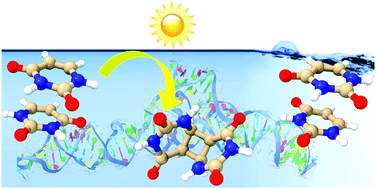On the propensity of formation of cyclobutane dimers in face-to-face and face-to-back uracil stacks in solution†
Abstract
UV irradiation of RNA leads to the formation of intra- and inter-strand crosslinks of cyclobutane type. Despite the importance of this reaction, relatively little is known about how the mutual orientation of the two bases affects the outcome of the reaction. Here we report a comparative nonadiabatic molecular dynamics study of face-to-back (F2B) and face-to-face (F2F) stacked uracil-water clusters. The computations were performed using the second-order algebraic-diagrammatic-construction (ADC(2)) method. We found that F2B stacked uracil-water clusters either relax non-reactively to the ground state by an ethylenic twist around the C![[double bond, length as m-dash]](https://www.rsc.org/images/entities/char_e001.gif) C bond or remain in the lowest nπ* state in which the two bases gradually move away from each other. This finding is consistent with the low propensity for the formation of intra-strand cyclobutane dimers between adjacent RNA bases. On the contrary, in F2F stacked uracil-water clusters, in addition to non-reactive deactivation, we found a pro-reactive deactivation pathway, which may lead to the formation of cyclobutane uracil dimers in the electronic ground state. On a qualitative level, the observed photodynamics of F2F stacked uracil-water clusters explains the greater propensity of RNA to form inter-strand cyclobutane-type crosslinks.
C bond or remain in the lowest nπ* state in which the two bases gradually move away from each other. This finding is consistent with the low propensity for the formation of intra-strand cyclobutane dimers between adjacent RNA bases. On the contrary, in F2F stacked uracil-water clusters, in addition to non-reactive deactivation, we found a pro-reactive deactivation pathway, which may lead to the formation of cyclobutane uracil dimers in the electronic ground state. On a qualitative level, the observed photodynamics of F2F stacked uracil-water clusters explains the greater propensity of RNA to form inter-strand cyclobutane-type crosslinks.

- This article is part of the themed collection: 2022 PCCP HOT Articles


 Please wait while we load your content...
Please wait while we load your content...